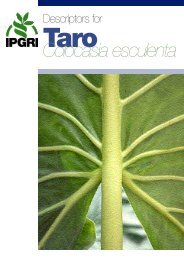Download PDF (6215 kb) - Bioversity International
Download PDF (6215 kb) - Bioversity International
Download PDF (6215 kb) - Bioversity International
You also want an ePaper? Increase the reach of your titles
YUMPU automatically turns print PDFs into web optimized ePapers that Google loves.
EUROPEAN CENTRAL FORAGES DATABASES 13<br />
such as the need for further collecting, prioritizing for safety-duplication of germplasm, the<br />
development of core collections, etc.<br />
Today, genebanks in the 30 ECP/GR countries conserve a total of about 97 000 accessions<br />
of forage species, of which approximately 65% have already been recorded in European<br />
Central Crop Databases (see relevant sections of the present report; Report of the Budapest<br />
documentation meeting, Oct. 1996). 10 These countries are heavily interdependent with<br />
regard to forages genetic resources. Europe has a long history and tradition of collaboration<br />
and free germplasm exchange. This has allowed significant progress to be made, in<br />
particular in rapidly raising the frequency of quantitative traits in breeding collections. The<br />
increasing privatization of breeding activities in the region is seen as potentially driving<br />
breeders to address short-term rather than long-term goals, resulting, inter alia, in neglecting<br />
the conservation of genetic resources. Furthermore, the exchange of germplasm and<br />
collaboration among breeders could be strongly reduced, bringing about a narrowing of the<br />
genetic basis of commercial varieties and ultimately an increased vulnerability of crops.<br />
Recognizing<br />
• that the long-term conservation of genetic resources and making these available to<br />
users is predominantly a public sector responsibility,<br />
• that a restriction of access to genetic resources among European countries would<br />
seriously impede the efforts of breeders,<br />
• that economic constraints call for a clear prioritization of genebank activities,<br />
• that no single country in Europe can, on its own, conserve all the forage genetic<br />
resources, and<br />
• that the Preparatory Meeting for Europe (Nitra, Slovakia, September 1995) and the<br />
Global Plan of Action (GPA) adopted in Leipzig, Germany (June 1996) call on ECP/GR<br />
to play a key role in facilitating the implementation of the GPA for the European<br />
region,<br />
the Working Group recommends the establishment of a decentralized European Forage<br />
Collection comprising the forage accessions that European genebanks would agree to<br />
maintain on behalf of all member countries of ECP/GR.<br />
Objectives<br />
The objectives of establishing this collection would be:<br />
• to formalize the sharing of responsibilities for the conservation of European forage<br />
genetic resources<br />
• to ensure the safe conservation of these accessions<br />
• to ensure the continued access to these accessions to all ECP/GR countries<br />
• to make information about the forage genetic resources available to the users through<br />
adequate forms of documentation (e.g. Central Crop Databases, European Internet<br />
Information Platform on Crop Genetic Resources, published reports of Working Group<br />
meetings, etc.)<br />
• to promote an intensive exchange of germplasm<br />
• to enhance the use of forage genetic resources<br />
• to reduce the workload for each country and allow a more effective conservation<br />
10 Lipman, E., M.W.M. Jongen, Th.J.L. van Hintum, T. Gass and L. Maggioni, compilers. 1997. Central<br />
Crop Databases: Tools for Plant Genetic Resources Management. <strong>International</strong> Plant Genetic<br />
Resources Institute, Rome, Italy/CGN, Wageningen, The Netherlands.




